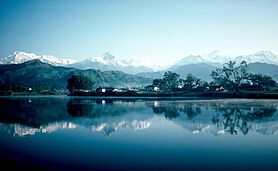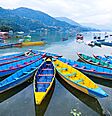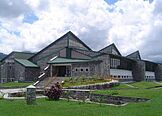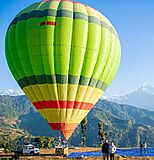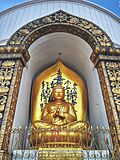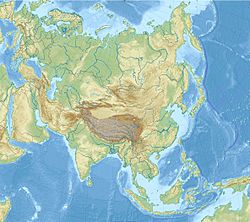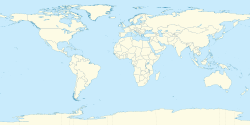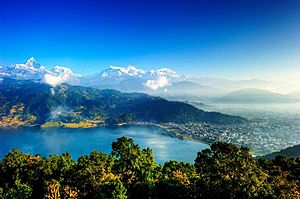Pokhara facts for kids
Quick facts for kids
Pokhara
पोखरा
|
||
|---|---|---|
|
Annapurna mountain reflected in Phewa lake
Boats in Baidam
International Mountain Museum
Matepani Gumba
Bindhyabasini Temple
Sarangkot
Pokhara Shanti Stupa
Poon Hill
|
||
|
||
| Nickname(s):
City of lakes , Tourism Capital of Nepal
|
||
| Motto(s): | ||
| Country | ||
| Province | Gandaki | |
| District | Kaski | |
| Incorporated | 1962 | |
| No. of Wards | 33 | |
| Government | ||
| • Type | Mayor-council | |
| • Body | Pokhara Metropolitan City Council | |
| Area | ||
| • Total | 464.24 km2 (179.24 sq mi) | |
| • Water | 4.4 km2 (1.7 sq mi) | |
| Area rank | 1st | |
| Elevation | 822 m (2,697 ft) | |
| Population
(2021)
|
||
| • Total | 599,504 | |
| • Rank | 2nd | |
| • Density | 1,291.367/km2 (3,344.62/sq mi) | |
| • Households | 120,594 (2nd most) | |
| Demonym(s) | Pokhareli | |
| Languages | ||
| • Official | Nepali and (Other Language) | |
| Ethnicities | ||
| • Ethnicities | Bahun, Gurung, Chhetri, Magar, Newar, | |
| Time zone | UTC+5:45 (NST) | |
| Postal Codes |
33700 (WRPD), 33702, 33704, 33706, 33708, 33713
|
|
| Area code(s) | 061 | |
Pokhara (Nepali: पोखरा) is a big city in central Nepal. It is the capital of Gandaki Province. In 2024, Pokhara was named the tourism capital of Nepal. It is the second largest city in Nepal by population, after Kathmandu. About 599,504 people lived there in 2021. Pokhara is the largest city in Nepal by land area.
The city is about 200 kilometers (124 miles) west of Kathmandu. It sits by Phewa Lake at an average height of 822 meters (2,697 feet) above sea level. The Annapurna mountain range is close by. It has three of the world's ten highest peaks: Dhaulagiri, Annapurna I, and Manaslu. These peaks are only 15 to 35 miles away.
Pokhara is a starting point for hikers exploring the Annapurna Circuit. This famous trail goes through the Annapurna Conservation Area in the Himalayas. The city is also home to many brave Gurkha soldiers. These soldiers from Nepal serve in armies around the world.
Contents
- What Does the Name Pokhara Mean?
- A Quick Look at Pokhara's History
- Pokhara's Geography
- Who Lives in Pokhara?
- How Does Pokhara Make Money?
- Hydroelectric Power Plants
- Temples, Monasteries, and Churches
- Where is Pokhara Located?
- Tourism in Pokhara
- Military Presence
- Electricity and Water
- Education in Pokhara
- Getting Around Pokhara
- Rivers and Lakes of Pokhara
- Sports and Fun Activities
- Music in Pokhara
- Media and Communication
- Famous People from Pokhara
- Images for kids
- See Also
What Does the Name Pokhara Mean?
The word "Pokhari" (Nepali: पोखरी) in Nepali means "pond." The name Pokhara is a different way of saying Pokhari. This is because the city has many ponds and lakes.
A Quick Look at Pokhara's History
Scientists have studied the ground in Pokhara Valley. They found signs of at least three big earthquakes in the past. These happened around 1000, 1255, and 1344 AD. There is also evidence of huge floods from the Annapurna mountains.
Pokhara was once an important stop on a trade route. This route connected China and India. In the 17th century, Pokhara was part of the Kingdom of Kaski. This kingdom was one of the 24 small kingdoms of Nepal. In 1786, Prithvi Narayan Shah added Pokhara to his kingdom. It was a key trading spot between Kathmandu, Jumla, India, and Tibet.
The first people likely settled in the valley around the mid-14th century. The first King of Kaski made Batulechaur his winter home. Later, in the 1770s, the king brought Newars from Kathmandu. They helped build the main market in Pokhara. Before that, most people lived in the hills around the city.
Today, many different groups live in Pokhara. These include Khas (like Brahmin and Chhetri), Gurungs, and Magar people. Newari people also make up a good part of the population. Batulechaur is known for the Gandharvas or Gaaineys, who are musicians.
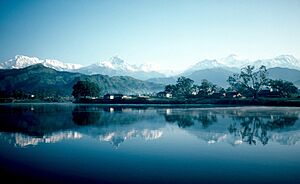
From 1959 to 1962, many people from Tibet came to Nepal. They were seeking safety after China took over Tibet. Many of these Tibetan exiles moved to India. However, about 20,000 Tibetans live in four settlements in and around Pokhara. These camps have become well-built communities. Each has a gompa (Buddhist monastery) and special Tibetan buildings.
Until the late 1960s, you could only reach Pokhara by walking. It was seen as a very special and remote place. The first road, the Siddhartha Highway, was finished in 1968. After that, tourism grew fast, and the city quickly expanded. The area along Phewa Lake, called Lakeside, is now a major tourist spot.
Pokhara's Geography
Western Nepal often experiences natural disasters. Pokhara is especially at risk from earthquakes and floods. This is because the Seti Gandaki River flows right through the city. For example, strong earthquakes hit Nepal in 2015.
Pokhara is in the northwest part of the Pokhara Valley. This valley is a wide area of the Seti Gandaki valley. The mountains here rise very quickly. Within 30 kilometers (19 miles), the land goes from 1,000 meters (3,281 feet) to 7,500 meters (24,606 feet) high. Because of this, Pokhara gets a lot of rain. It receives about 3,350 mm (131 inches) of rain each year. The northern part of the city, closer to the mountains, gets even more rain.
The Seti Gandaki is the main river in Pokhara. This river and its smaller streams have carved deep gorges and canyons. These create interesting terraced areas in and around the city. Some of these gorges are hundreds of meters deep and only a few meters wide.
To the south, the city touches Phewa Tal (or Phewa Lake). This lake is 4.4 square kilometers (1.7 square miles) big. It is about 800 meters (2,625 feet) above sea level. North of Pokhara, the village of Lumle is at 1,740 meters (5,709 feet). It is at the foot of the Annapurna mountain range.
Pokhara is known as the "city of lakes." You can see three 8,000-meter peaks from the city: Dhaulagiri, Annapurna, and Manaslu. The Machhapuchchhre mountain, also called "Fishtail," is 6,993 meters (22,943 feet) high and is the closest to the city.
The ground in Pokhara valley is porous, which means it has many holes. This helps form caves. Several caves are found within the city and nearby areas. South of the city, water from Phewa Lake flows into a stream. This stream disappears into an underground gorge at Patale Chhango. This place is also called Davis Falls. The water then reappears about 500 meters (1,640 feet) further south.
Pokhara's Climate
Pokhara has a humid subtropical climate. However, its high elevation keeps the temperatures mild. In summer, temperatures are usually between 25 and 35 °C (77 and 95 °F). In winter, they are around -2 to 15 °C (28 to 59 °F). Pokhara gets a lot of rain, especially during the monsoon season from June to September. Lumle, near Pokhara, gets the most rainfall in Nepal. Snowfall does not happen in the valley itself, but the hills around it sometimes get snow in winter. Winter and spring days are usually clear and sunny.
The hottest temperature ever recorded in Pokhara was 38.5 °C (101.3 °F) on May 4, 2013. The coldest was 0.5 °C (32.9 °F) on January 13, 2012.
| Climate data for Pokhara (1991–2020, extremes 1969–2020) | |||||||||||||
|---|---|---|---|---|---|---|---|---|---|---|---|---|---|
| Month | Jan | Feb | Mar | Apr | May | Jun | Jul | Aug | Sep | Oct | Nov | Dec | Year |
| Record high °C (°F) | 29.5 (85.1) |
31.7 (89.1) |
35.0 (95.0) |
37.4 (99.3) |
38.5 (101.3) |
37.0 (98.6) |
36.8 (98.2) |
35.6 (96.1) |
34.0 (93.2) |
32.0 (89.6) |
30.8 (87.4) |
25.5 (77.9) |
38.5 (101.3) |
| Mean daily maximum °C (°F) | 19.9 (67.8) |
22.7 (72.9) |
27.1 (80.8) |
30.0 (86.0) |
30.4 (86.7) |
30.8 (87.4) |
30.4 (86.7) |
30.5 (86.9) |
29.9 (85.8) |
27.9 (82.2) |
24.4 (75.9) |
21.0 (69.8) |
27.1 (80.8) |
| Daily mean °C (°F) | 13.5 (56.3) |
16.2 (61.2) |
20.1 (68.2) |
23.1 (73.6) |
24.6 (76.3) |
26.0 (78.8) |
26.4 (79.5) |
26.4 (79.5) |
25.5 (77.9) |
22.6 (72.7) |
18.4 (65.1) |
14.7 (58.5) |
21.5 (70.7) |
| Mean daily minimum °C (°F) | 7.1 (44.8) |
9.7 (49.5) |
13.1 (55.6) |
16.1 (61.0) |
18.7 (65.7) |
21.2 (70.2) |
22.4 (72.3) |
22.3 (72.1) |
21.1 (70.0) |
17.2 (63.0) |
12.3 (54.1) |
8.3 (46.9) |
15.8 (60.4) |
| Record low °C (°F) | 0.5 (32.9) |
2.2 (36.0) |
4.8 (40.6) |
6.0 (42.8) |
7.9 (46.2) |
12.0 (53.6) |
13.0 (55.4) |
13.8 (56.8) |
15.9 (60.6) |
10.0 (50.0) |
4.0 (39.2) |
0.8 (33.4) |
0.5 (32.9) |
| Average precipitation mm (inches) | 21.6 (0.85) |
35.1 (1.38) |
63.7 (2.51) |
141.7 (5.58) |
354.7 (13.96) |
648.2 (25.52) |
941.0 (37.05) |
839.4 (33.05) |
635.0 (25.00) |
159.2 (6.27) |
17.2 (0.68) |
11.5 (0.45) |
3,868.3 (152.30) |
| Average precipitation days (≥ 1.0 mm) | 2.4 | 3.8 | 6.4 | 10.5 | 18.3 | 22.2 | 25.6 | 24.3 | 19.4 | 8.0 | 1.3 | 1.0 | 143.2 |
| Source 1: World Meteorological Organization | |||||||||||||
| Source 2: Department of Hydrology and Meteorology | |||||||||||||
Who Lives in Pokhara?
In 2021, Pokhara Metropolitan City had a population of 599,504 people. Most people (78.8%) speak Nepali. Other languages spoken include Gurung (11%), Magar (2.4%), and Newar (2.4%).
Many different ethnic groups live in Pokhara. The largest groups are Hill Brahmin (28.0%), Gurung (16.1%), and Chhetri (15.4%). Other groups include Magar, Kami, and Newar.
Most people in Pokhara follow Hinduism (82.4%). About 13.2% are Buddhist, and 2.4% are Christian.
| Religion in Pokhara (2021) | ||||
|---|---|---|---|---|
| Religion | Percent | |||
| Hinduism | 82% | |||
| Buddhism | 13% | |||
| Christianity | 2% | |||
| Others | 2% | |||
Caste and Ethnic groups in Pokhara Hill Brahman (28%) Gurung (16%) Chhetri (15%) Magar (9%) Kami (7%) Newar (5%) others (20%)
language in Pokhara Nepali (79%) Gurung (11%) Magar (2%) Newari (2%) Others (6%)
How Does Pokhara Make Money?
Pokhara has grown very quickly since the 1990s. The city's economy now relies more on services and tourism than on farming. This growth has also made land prices very high. The main ways Pokhara makes money are from manufacturing, services (like tourism), farming, and money sent home by people working abroad. Tourism, services, and manufacturing make up about 58% of the economy. Money from abroad adds about 20%, and farming adds nearly 16%.
Hydroelectric Power Plants
Pokhara has several power plants that use water to make electricity. These include:
- Fewa Hydropower Station
- Seti Hydropower Station
- Bijayapur-I Small Hydropower Project
- Bijaypur Khola-2 Hydropower Project (under Construction)
Temples, Monasteries, and Churches
There are many places of worship in and around Pokhara. These include Hindu temples, gumbas (Buddhist monasteries), and churches. Some temples are used by both Hindus and Buddhists. Some popular places are:
- Tal Barahi Temple (on an island in Phewa Lake)
- Bindhyabasini temple
- World Peace Pagoda
- Lord Shiva Statue
- Bhadrakali Temple
- Matepani Gumba
- Akala Devi Temple
- Nepal Christiya Ramghat Church (the first church in Nepal, built in 1952 AD)
- Bhimsen Temple
Where is Pokhara Located?
Pokhara is about 12 kilometers (7.5 miles) long from north to south. It is 6 kilometers (3.7 miles) wide from east to west. Unlike Kathmandu, Pokhara has a lot of green space. The Seti River flows through a gorge in the city. There are five bridges crossing this gorge. The valley floor is flat and looks like the Terai region. Hills surround the city, offering great views.
Phewa Lake was made a bit bigger by a dam. However, the lake is at risk of filling up with dirt during the monsoon season. The water flowing out of the lake is used to make electricity at Fewa Hydropower Station. The dam broke in 1974, which drained the lake. It was later rebuilt. Water from Phewa Lake is also used to water farms in the southern Pokhara valley. The eastern valley gets water from a canal that starts from the Seti River. Some parts of Phewa Lake are used for fish farming. The lake is currently being taken over by an invasive plant called water hyacinth.
In 2017, Pokhara Lekhnath Metropolitan City became Nepal's largest city by area. It covers 464.24 square kilometers (179.24 square miles). This means it is nine times bigger than Kathmandu!
Pokhara is a very popular place for tourists from all over the world. Many people visit to hike in the Annapurna range or go to the famous religious site of Muktinath. The main tourist area is along the north shore of Phewa Lake. This area has small shops, hotels, restaurants, and bars. More fancy hotels are on the southern shore of the lake. Most tourists who visit Pokhara go hiking to the Annapurna Base Camp and Mustang. East of Pokhara valley, there are seven smaller lakes. These include Begnas Lake and Rupa Lake. Begnas Lake is known for its fish farms.
Tourism in Pokhara
After China took over Tibet in 1950 and the Indo-China war in 1962, the old trade route between Tibet and India through Pokhara stopped being used. Today, only a few groups from Mustang still come to Bagar.
In recent years, Pokhara has become a major tourist spot. It is known as Nepal's tourism capital, especially for adventure travel. It is the starting point for the famous Annapurna Circuit trek. Tourism is a big part of the local economy. It is the main way people in the city earn money. Pokhara has many hotels, including two 5-star hotels and over 300 other hotels.
The city has two main viewpoints for seeing the city and mountains. These are the World Peace Pagoda, built in 1996, and Sarangkot, which is northwest of the city. In 2004, the International Mountain Museum (IMM) opened. Other museums include the Pokhara Regional Museum and the Annapurna Natural History Museum. The Gurkha Museum tells the story of the Gurkha soldiers.
Cable Cars
The Annapurna Cable Car takes tourists from Lakeside to Sarangkot. Another cable car is being built to connect Phewa Lake with the World Peace Stupa.
Military Presence
The Pokhara area has a strong military history. Many men from the region join the Nepali army. The main office for the Western Division of the Nepalese Army is in Bijayapur, Pokhara. Both the British Army and the Indian Army have recruitment and pension offices in Pokhara for Gurkha soldiers.
Electricity and Water
Electricity in Pokhara is managed by the NEA Nepal Electricity Authority. Water and sanitation services are provided by the Nepal Water Supply Corporation (NWSC).
Education in Pokhara
Pokhara has over 800 private and public schools. There are also many colleges and universities. Students can study various subjects, including social sciences, business, science, and technology.
Getting Around Pokhara
Public Transportation
Pokhara has a large public transportation system. It is run by private companies. Buses, micro-buses, and taxis operate throughout the city and nearby villages. The Purano Bus Park is the main station for buses traveling across the country.
Traveling Between Cities
Pokhara is well connected to other parts of Nepal by roads and flights. The main ways to travel are by cars, motorbikes, public buses, and taxis. The Pokhara Airport has regular flights to Kathmandu and Mustang. A new Pokhara International Airport has also opened for more flights. A flight from Kathmandu to Pokhara takes about 30 minutes.
Rivers and Lakes of Pokhara
Pokhara valley has many water sources. The main lakes and rivers are:
Lakes
- Phewa Lake
- Begnas Lake
- Rupa Lake
- Dipang Lake
- Khaste lake
- Maidi Tal
- Niureni Tal
- Gude Tal
- Kamal Pokhari Tal
- Kashyap Tal (Thuli Pokhari)
Rivers
- Seti Gandaki (Seti Khola)
- Kahun Khola
- Bijaypur Khola
- Furse Khola
- Kali Khola
- Yamdi Khola
- Mardi River
- Harpan Khola
- Hadi Khola
Sports and Fun Activities
Sports in Pokhara mostly happen at the Pokhara Rangasala stadium. Popular sports include football, cricket, volleyball, and basketball. The Sahara Club helps promote football and organizes a big annual tournament called the Aaha Gold Cup. Other football tournaments are also held.
There are several tennis courts. The Himalayan Golf Course is famous for its unique design. Near Sarangkot hill, you can try exciting activities like paragliding and skydiving. The Pokhara city marathon and high-altitude marathon are also popular events. Adventure sports like base jumping, canyoning, rock climbing, and bungee jumping attract many tourists. The Pokhara Rhinos team represents the city in the Everest Premier League cricket tournament.
Music in Pokhara
Traditional Nepali music uses instruments like the madal (a small drum), bansuri (bamboo flute), and saarangi. These instruments are important in the folk music of Pokhara. Famous folk songs from this region include Resham Firiri and Khyalee Tune.
Folk music started being played on Radio Nepal in the 1950s. Artists like Jhalakman Gandharva helped bring this music to more people. In the 1990s, bands from Pokhara, like Nepathya, started mixing Western rock and pop with traditional folk music. Many other Nepali bands now play this style.
Another important part of music in Pokhara is the Panché Baaja. This is a traditional band that plays during weddings.
Pokhara's music scene is always changing. Western rock, pop, rap, and hip-hop are becoming popular. Many music concerts are held in the city. However, traditional folk music and modern Nepali music are still very popular with most people. Pokhara hosts more music concerts than any other city in Nepal.
Media and Communication
Media and communication were limited in Pokhara until the 1990s. But in the next ten years, many private radio and television stations started. There are 19 local FM radio stations in Pokhara. Four FM stations from Kathmandu also have relay stations here. There are also six community radio stations and five television stations.
About 14 national daily newspapers are published in Nepali in Pokhara. Many weekly and monthly news magazines are also available. All major national newspapers from Kathmandu are sold in Pokhara. Many online news websites are also updated from Pokhara.
Pokhara has 4G internet service from Nepal Telecom, Smart Cell, and Ncell. Most people use their phones, internet cafes, or local wireless internet to get online. Many tourist restaurants and hotels offer WiFi. Nepal Telecom also launched public Wi-Fi hotspots in 2014. Several private companies provide internet services to homes and businesses.
Famous People from Pokhara
People who live or have lived in Pokhara are called Pokhareli. The Gurung people are the main ethnic group. They come from the hills around Pokhara, like Sikles and Ghandruk. Other groups include Brahmin, Newar, and Magar people. Pokhara also has the most Gurkha soldiers. Most of them are from the Gurung and Magar ethnic groups.
Images for kids
See Also
 In Spanish: Pokhara para niños
In Spanish: Pokhara para niños


